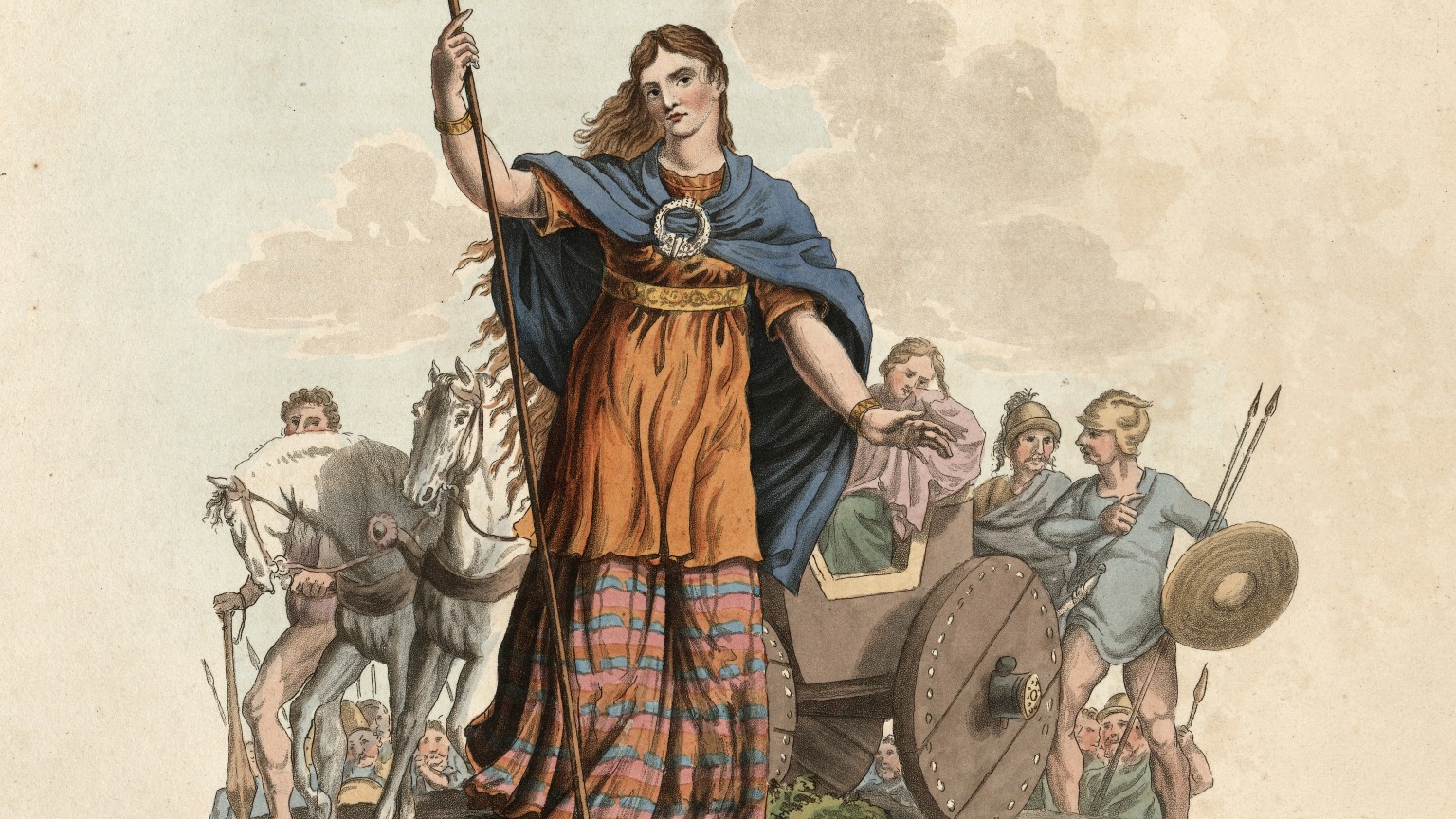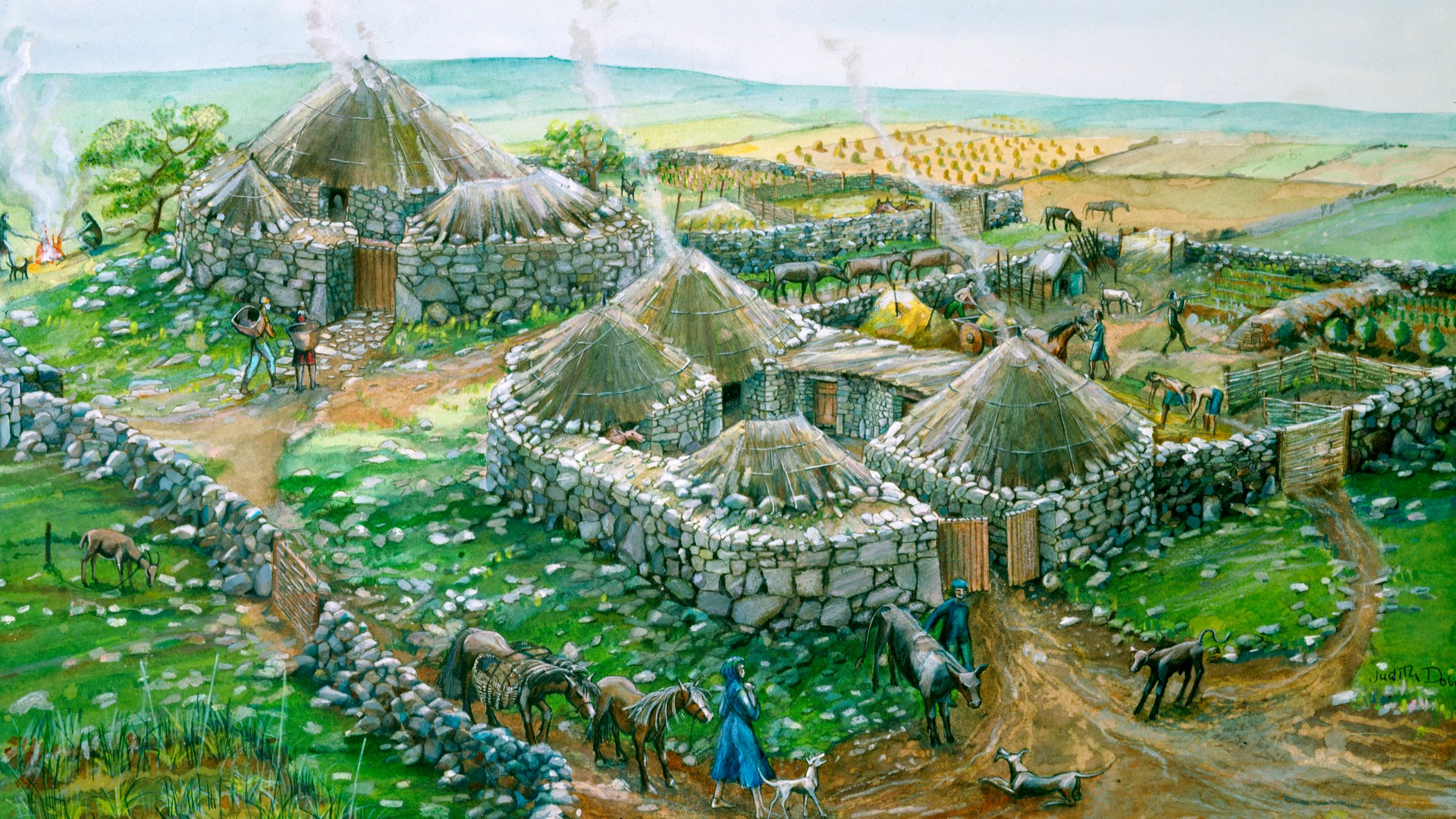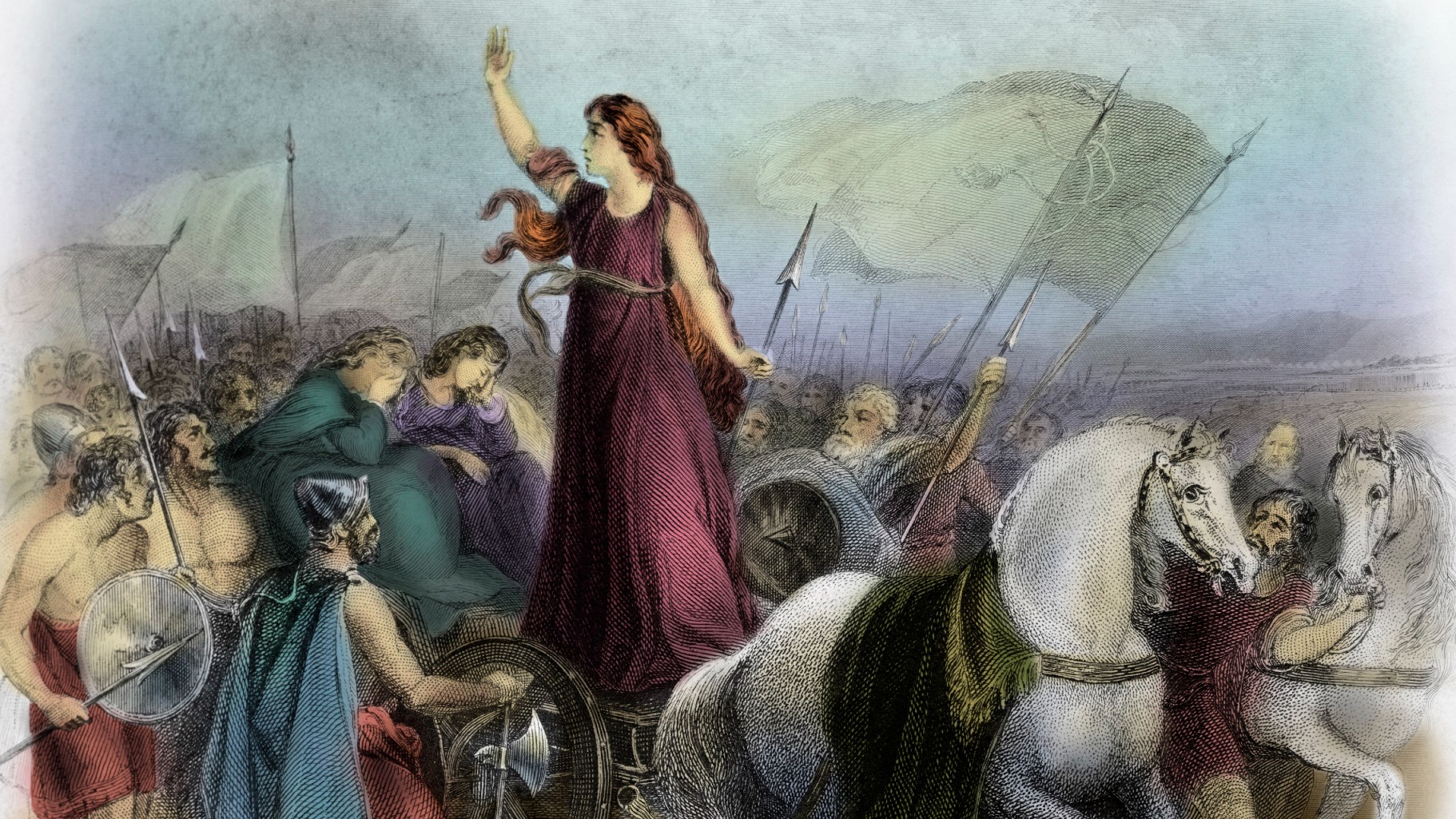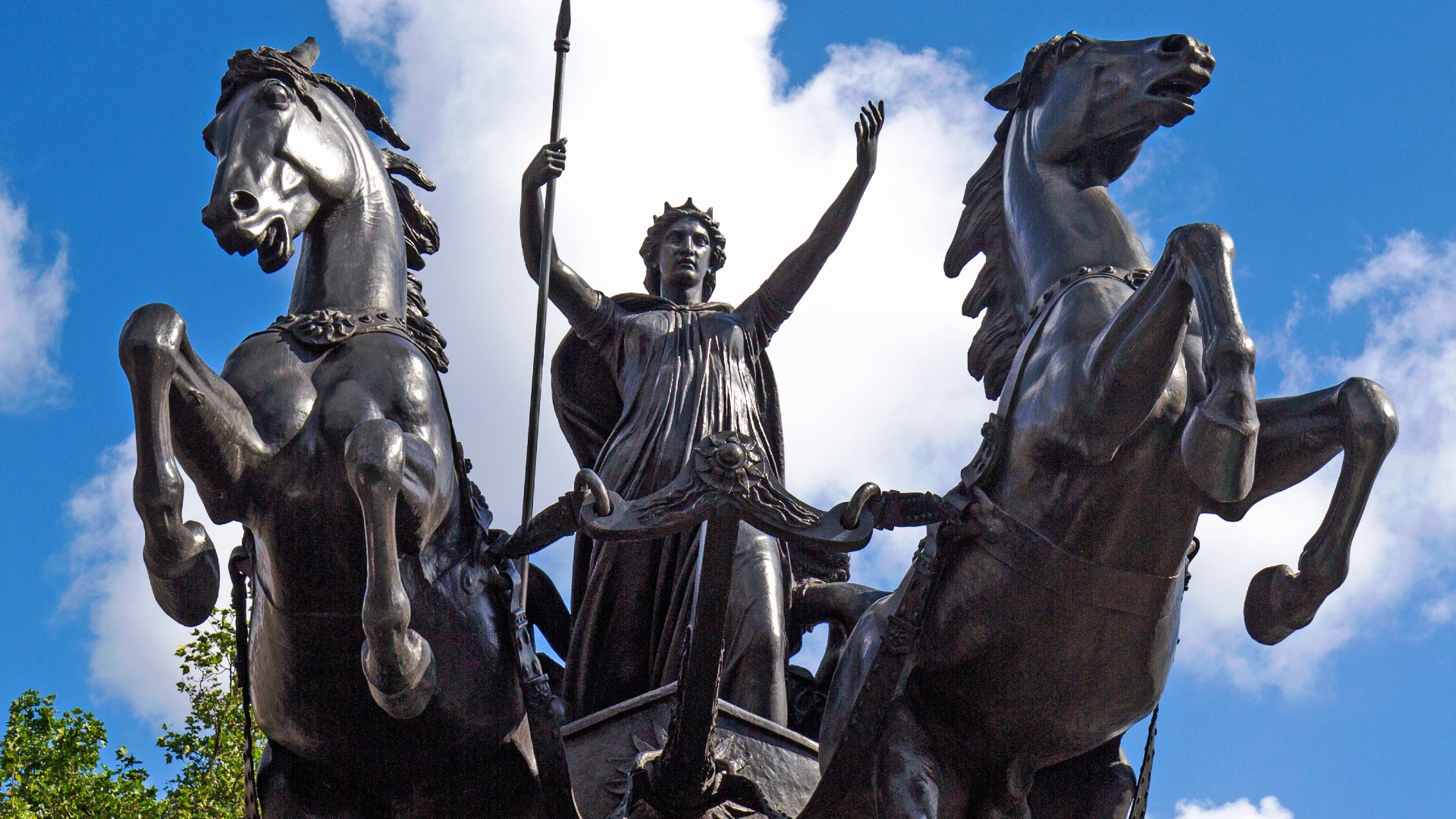Boudica: Warrior queen of the Iceni
Boudica was queen of the Iceni tribe in England and led a rebellion against Roman occupation around 60 A.D.

Boudica (also spelled Boudicca or Boudicea) was the queen of the Iceni, a small but powerful tribe based in modern day Norfolk, in eastern England. In A.D. 60, she led a revolt against the Romans that resulted in the destruction of at least two Roman settlements, including Londinium (modern London) and almost drove Rome's imperial occupation forces off the island.
The revolt began after the death of her husband, Prasutagus, around A.D. 60. According to Publius Cornelius Tacitus, who along with Cassius Dio is one of two ancient historians who record the life and revolt of Boudica, the Romans seized Iceni property, flogged Boudica and raped her two daughters. Dio differs on these last elements and does not mention the flogging of Boudica or the rape of her daughters, and claims the uprising was over a Roman loan. In either case, Boudica raised an army and led a rebellion against the Romans which, after initial success, was crushed at the Battle of Watling Street.
In the deeply patriarchal society of imperial Rome, the fact that a woman had succeeded in killing so many Romans was considered a huge blow. "Two cities were sacked, eighty thousand of the Romans and of their allies perished, and the island was lost to Rome. Moreover, all this ruin was brought upon the Romans by a woman, a fact which in itself caused them the greatest shame," wrote Dio in "Roman History" (translation by Earnest Cary, through The University of Chicago).
The only physical description of Boudica that survives comes from Dio. Although it may not be accurate, it leaves readers with the impression that Boudica was a determined war leader. "In stature she was very tall, in appearance most terrifying, in the glance of her eye most fierce, and her voice was harsh; a great mass of the tawniest hair fell to her hips; around her neck was a large golden necklace; and she wore a tunic of divers colours over which a thick mantle was fastened with a brooch. This was her invariable attire …" wrote Dio, who added that she clutched a spear when she spoke to her people.
Roman Britain before the rebellion

The Roman Empire, under Emperor Claudius, launched a successful invasion of Britain in A.D. 43 with an army estimated by Joan P. Alcock in "A Brief History of Roman Britain" (Robinson Publishing, 2011) to be around 40,000 men. Military campaigns had been launched by earlier Roman leaders against the Brits (one notably led by Julius Caesar) but this time the Romans were here to stay.
"I think that Roman Britain was always the wild northwest of the empire, a place of difference given the far north was never fully conquered, requiring a huge military presence to maintain the northern border. I estimate this at around 12 percent of the entire military establishment in what was only four percent of the geographic area of the empire," said Simon Elliott, author of "Roman Conquests: Britain" (Pen and Sword Military, 2021), in an interview with All About History. "On a number of occasions I think Roman emperors considered abandoning their occupation here, one certainly in the context of the Boudiccan Revolt when Nero must surely have wondered if the province was worth the effort of holding."
Force wasn't the only tactic used to hold Britain, however. Several leaders offered to make their kingdoms "client-states" of Rome. This basically meant that as long as their leaders lived, and did Rome's bidding when asked, they could maintain some level of sovereignty within the Roman Empire. The Iceni were one of the tribes who agreed to this arrangement and they remained a client state of Rome up until the death of Prasutagus around A.D. 60.
Get the world’s most fascinating discoveries delivered straight to your inbox.
The Iceni, at the time of the Roman invasion, were a wealthy people, as evidenced by hoards of precious metals that have been found, such as a gold coin hoard reported by the BBC in 2011. Its leaders had been minting coins for nearly a century.
Even before Boudica, the Iceni's client-state relationship with Rome was problematic. In A.D. 47, a short-lived unsuccessful revolt was launched by the Iceni against Rome. This rebellion may have led to the elevation of Prasutagus to the leadership of the tribe, perhaps being seen by the Romans as a leader who could keep the Iceni in line.
Even in his will, Prasutagus tried to strike a balance between the Iceni and the Romans. In it he left his kingdom to his two daughters and the Roman emperor Nero. The exclusion of Boudica in his will has led historians to speculate that, even when her husband was still alive, the Iceni queen held strong anti-Roman views.
This client-state arrangement came crashing down upon the death of Prasutagus, however, with the Romans treating the Iceni, Boudica and her daughters terribly. His "kingdom was plundered by centurions, his house by slaves, as if they were the spoils of war. First, his wife Boudicea was scourged (flogged), and his daughters outraged. All the chief men of the Iceni, as if Rome had received the whole country as a gift, were stripped of their ancestral possessions, and the king's relatives were made slaves..." wrote Tacitus in "The Annals" (Translation by Alfred John Church, through Perseus Digital Library)
Boudica's rebellion

With her kingdom's independence lost, her daughters raped, and herself having been personally flogged, Boudica had had enough. She raised an army, gaining support from another aggrieved tribe known as the Trinovantes.
"It seems as soon as a realistic opportunity presented itself to throw off the yoke of Rome the leading regional aristocrats did so, aligning their fate (fatally as it turned out) to that of Boudica and the Iceni. The really interesting question here actually is why did the Cantiaci [another powerful tribe] not join the revolt, with the answer perhaps that they were at that time the most Romanised of the British tribes given their proximity to the continent?" said Elliott.
Boudica focused her wrath on the Roman settlements of Camulodunum (modern-day Colchester) and Londinium (London), burning both of them to the ground. Archaeologists have found evidence of the fires her forces lit.
"At Camulodunum and Londinium the results of the Boudican revolt may be compared, on a smaller scale, with those of the volcanic eruptions that smothered Pompeii and Herculaneum," write researchers Richard Hingley and Christina Unwin in their book, "Boudica: Iron Age Warrior Queen" (Bloomsbury Academic, 2006). The towns were destroyed. In addition, Tacitus claims that " also destroyed the town of Verulamium, although the archaeological evidence for this is less clear.
Boudica was helped by the fact that at the time her rebellion was launched much of the Roman army in Britain was on the Isle of Anglesey, in Wales, destroying a Druid site at Mona. This meant that, for a while, the rebels would only encounter small numbers of Roman troops. After her successes, Dio records, Boudica's army had swelled to 230,000 people, a figure that was probably exaggerated.
"[The revolt] caught the Romans cold given the far away deployment of their legions, with legio XIV Gemina and legio XX Valeria Victrix with Paulinus, legio II Augusta in Exeter and legio IX Hispana in southern Lincolnshire. In short, the Romans completely overplayed their hand in terms of civil government when trying to incorporate the territory of the Iceni into the province, and then when things went badly for them didn't have the available military resources to deal with the fall out," said Elliott.
Battle of Watling Street

According to David Mattingly, a professor at the University of Leicester, the Roman commander on the island, Gaius Suetonius Paulinus, amassed what forces he could, numbering perhaps only 10,000 men. He gave battle to Boudica somewhere near Watling Street, an ancient road on the island. While Paulinus was heavily outnumbered, he did have several other advantages. His legionnaires were well trained, equipped and probably battle hardened. Boudica's forces on the other hand were anything but.
In "a fast-moving rebellion there was neither time to fabricate large numbers of arms, nor, evidently, was there the opportunity for rebel forces to pillage major stockpiles of Roman weaponry," wrote Mattingly in "An Imperial Possession: Britain in the Roman Empire" (Penguin Books, 2008). He notes that while a "core" of Boudica's army was properly armed "many of the rebels will have had no body armour and will have been provided with makeshift weapons, such as agricultural tools."
Additionally, while scholars don't know precisely where Paulinus engaged Boudica, we know from Tacitus that it was in a "narrow defile" with a forest at the rear. This meant that Boudica could not bring her superior numbers to bear on the Roman forces. Also, Tacitus notes that Boudica made a tactical mistake in placing her supply wagons close to the front lines, blocking her troops when they had to retreat.
The Roman legions started the battle by launching spears at the British. These spears would have killed some Brits and hit the shields of others, possibly sticking to them and rendering them useless. Then the Roman troops "rushed out in a wedge-like column. Similar was the onset of the auxiliaries, while the cavalry with extended lances broke through all who offered a strong resistance." The rebels tried to flee but "flight proved difficult, because the surrounding wagons had blocked retreat," wrote Tacitus. The Romans massacred all who they could, even killing the animals which the rebels used to move their supplies.
The battle over, Tacitus said that Boudica took poison to avoid being captured, while Dio said that she died of illness (possibly from a wound). According to Mattingly Paulinus then "set about re-subjugating the implicated areas by 'fire and sword' and this extended not only to the most hostile peoples, but also even to those who had simply wavered in their loyalty." Britain would remain part of the Roman Empire until the fifth century A.D. when the western half of the empire collapsed.
"The emperor, Roman political establishment and Roman military all knew that the Boudiccan revolt was a close-run thing. They all knew that the great Augustus' lowest moment had been the loss of Varus' three legions to the Germans in the Teutoburg Forest in AD 9. The jeopardy in Britain in AD 60/61 were even greater, with four legions in danger, and with an emperor far less secure in his position. In short, the Romans knew that any overall loss to Boudica would have been disastrous. Indeed, you can see this in their response after Paulinus final victory. This included drafting in 2,000 more legionaries from Germany together with 1,000 auxiliary cavalry and eight units of auxiliary foot to help stamp out the last flames of resistance. This was then carried out with such vigor in the Iceni homelands of north Norfolk that the region remained for many years under-developed compared to the rest of the province," said Elliott.
The legacy of Boudica

While Boudica's rebellion failed to drive the Romans out of Britain, the Iceni queen has become something of a modern-day heroine.
"Boudica has become an icon of British national history and is now a symbol not only of British freedom but also of women's power," wrote University of Newcastle classics professor Marguerite Johnson in "Boudicca" (Bristol Classical Press, 2012). "She has been painted and sculpted; she has 'starred' in films and has been the protagonist of numerous books, both of an academic and fictional nature."
In 1902, not long after the death of Queen Victoria a statue of Boudica was unveiled next to Westminster Bridge in London. Standing in her war chariot, and clutching a spear, it shows the Iceni queen ready to take on the might of Rome.
Additional resources
Want to learn about some of the incredible women from within Rome? Then we have 8 powerful female figures for you to read about.
Boudica's rebellion didn't bring down the Roman Empire, but it scared Rome enough to react. So, what did bring down the Roman Empire in the end?
Bibliography
- "Roman History" by Cassius Dio (translation by Earnest Cary, The University of Chicago)
- "A Brief History of Roman Britain" by Joan P. Alcock (Robinson Publishing, 2011)
- "Roman Conquests: Britain" by Simon Elliott (Pen and Sword Military, 2021)
- "Iceni gold coin hoard clean-up at Ipswich Museum" BBC
- "Boudica Britannia" by Miranda Aldhouse-Green (Routledge, 2021)
- "The Annals" by Publius Cornelius Tacitus (Translation by Alfred John Church, Perseus Digital Library)
- "Boudica: Iron Age Warrior Queen" (Bloomsbury Academic, 2006)
- "An Imperial Possession: Britain in the Roman Empire" by David Mattingly (Penguin Books, 2008)
- "Boudicca" by Marguerite Johnson (Bristol Classical Press, 2012)

Owen Jarus is a regular contributor to Live Science who writes about archaeology and humans' past. He has also written for The Independent (UK), The Canadian Press (CP) and The Associated Press (AP), among others. Owen has a bachelor of arts degree from the University of Toronto and a journalism degree from Ryerson University.
- Jonathan GordonEditor, All About History


